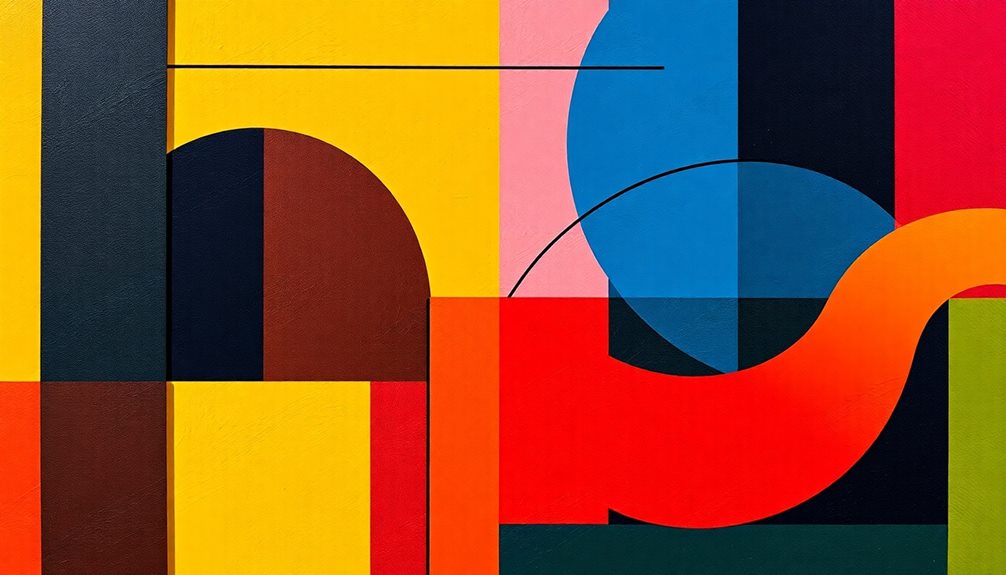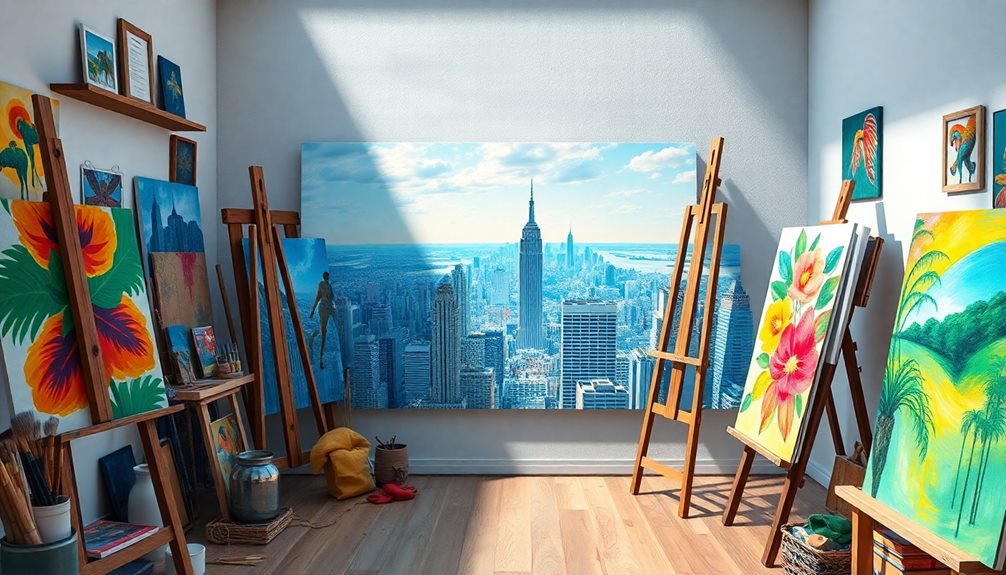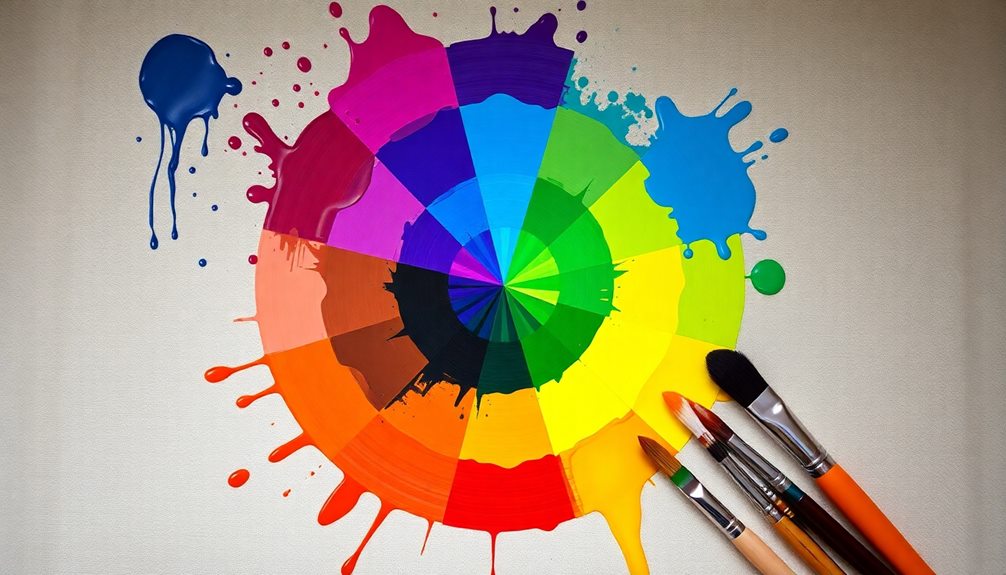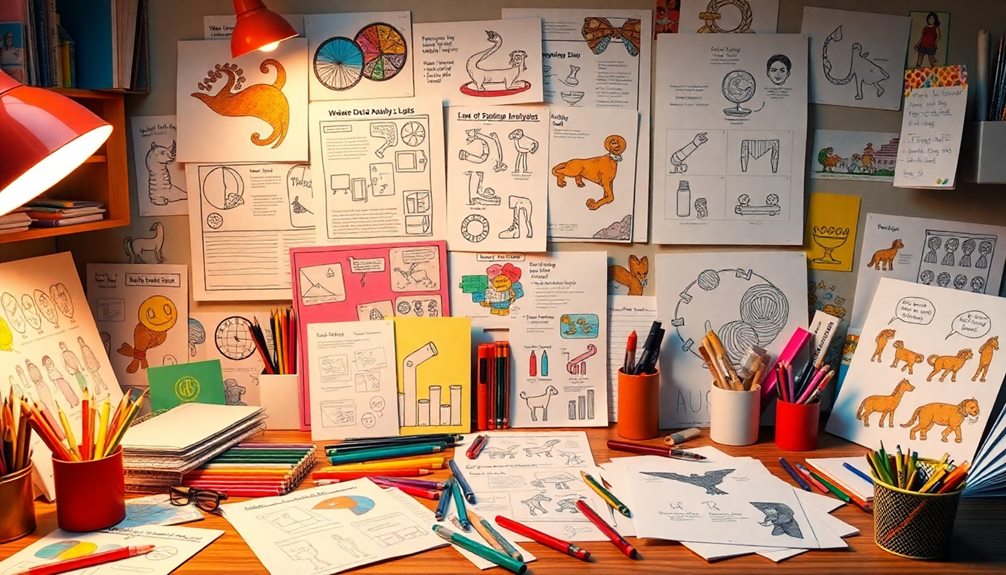Understanding scale and proportion is essential for creating visually appealing art and design. Scale refers to the size of an object compared to others, while proportion deals with the size relationships within a single object. Proper use of these principles fosters harmony and balance, while mistakes can lead to awkward visuals. In art, scale can evoke powerful emotions, whether it's awe from large works or intimacy from smaller pieces. In design, mastering these concepts enhances usability and comfort. You'll discover even more insights on how to effectively apply scale and proportion in your own work.
Key Takeaways
- Scale refers to the size of an object relative to others, while proportion relates to the size relationships among parts of a single object.
- Effective use of scale and proportion creates visual harmony, balance, and directs the viewer's attention in art and design.
- Larger elements within a composition typically attract more attention, while smaller details invite closer inspection and engagement.
- The golden ratio is a mathematical principle that enhances visual harmony and balance in artistic and design compositions.
- Misjudging scale and proportion can lead to awkward visuals and disjointed compositions, impacting the overall aesthetic and functionality.
Definition of Scale and Proportion

Scale and proportion are fundamental concepts in art and design that shape how we perceive objects and their relationships. Scale refers to the size of an object in relation to others, while proportion deals with the relative sizes of different parts within a single object or composition.
When you think about proportion, consider the human body. It often serves as a standard for judging proportionality, with ideal proportions historically influenced by mathematical ratios, such as the golden ratio.
Using proportion effectively can evoke feelings of harmony and balance in your designs. Conversely, disproportionate elements can attract attention and create visual interest.
If you misjudge scale, though, you might distort perception, leading to confusion or misinterpretation of your artwork. Both scale and proportion are essential for establishing visual hierarchy, guiding viewers through your work, and enhancing its emotional impact.
Importance in Art

When you look at a piece of art, the scale and proportion can hit you right in the emotions. A massive painting might leave you in awe, while a smaller work invites you to appreciate its intricate details.
Emotional Impact of Scale
Experiencing art often hinges on the emotional impact of its scale, which can profoundly alter how you perceive and connect with a piece. The size of an artwork influences your feelings, whether evoking awe or intimacy.
Here are some ways scale affects your experience:
- Large-scale works create a sense of grandeur, dominating their surroundings, like the Great Wall of China.
- Smaller artworks foster intimacy, inviting you to engage closely and appreciate intricate details, as seen in Persian miniature paintings.
- Exaggerated scale enhances visual experience, drawing attention to specific details, similar to Chuck Close's photorealism.
- Cultural significance often ties to scale, with large pieces like Hokusai's Great Wave embodying nature's power and shaping public perception.
Artists expertly manipulate scale and proportion to forge emotional connections. For instance, Michelangelo's David, towering over 13 feet, imposes a strong presence, while smaller pieces can create a profound sense of closeness.
Understanding how scale influences your emotional response can deepen your appreciation for art, leading to more meaningful connections.
Guiding Viewer's Eye
How do artists draw you into their work? They skillfully use scale and proportion to guide your eye and create a dynamic visual experience. By manipulating these elements, artists establish a focal point or emphasis that naturally captures your attention. For instance, larger elements in a composition often stand out, drawing you in and leading you on a journey through the artwork.
Proportion plays a critical role, too; it helps elements relate to each other, creating visual harmony that allows your gaze to flow smoothly across the piece. Many artists employ techniques like the golden ratio to achieve a balanced composition, enhancing your understanding of the work as you explore it.
On the other hand, disproportionate elements can introduce tension and intrigue. These unexpected sizes encourage you to investigate the artwork more thoroughly, as you navigate the contrasts and complexities of the piece.
Ultimately, the thoughtful use of scale and proportion not only enhances your visual experience but also deepens your engagement with the art, making every viewing an opportunity for connection and discovery.
Application in Design
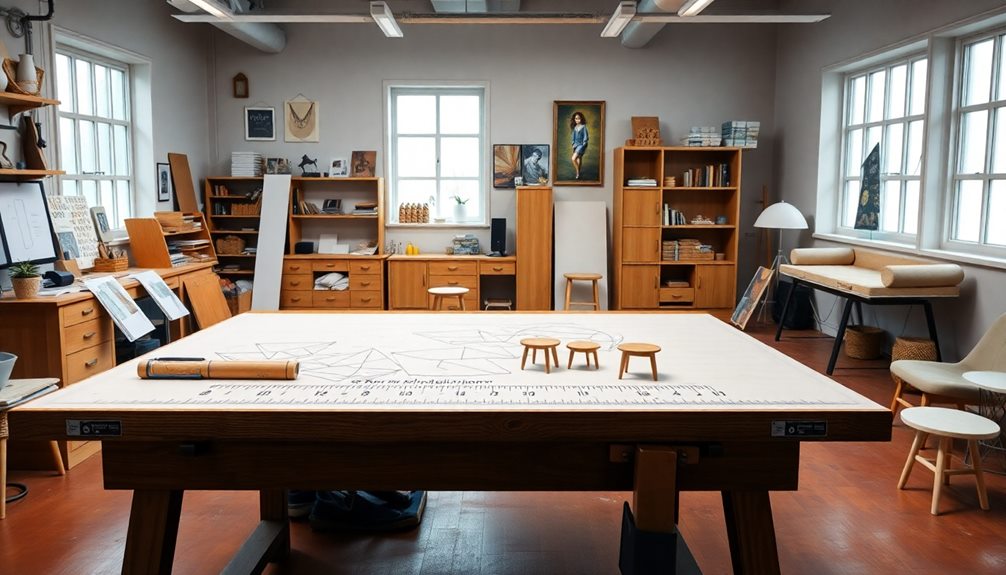
When you design, scale and proportion are key to creating functional elements that enhance usability.
Properly applying these principles allows for a harmonious balance between different design elements, ensuring that each component complements the others effectively.
By establishing a clear visual hierarchy, you guide the viewer's attention, making it easier for them to navigate your space or product.
Understanding how these concepts work together can greatly improve your design outcomes, especially when considering creating an interior design mood board.
Functional Design Elements
Incorporating functional design elements is essential for creating spaces and products that truly meet users' needs. When you prioritize size and proportion in art, you enhance usability and comfort across various design fields.
For example, in modern farmhouse design, the use of natural materials and a neutral color palette can contribute to a harmonious atmosphere that feels inviting and spacious. Here are some critical aspects to take into account:
- Architectural Design: Verify door heights and room sizes accommodate average human proportions for accessibility.
- Graphic Design: Use the golden ratio to establish visual hierarchy, making headlines and images appropriately sized for maximum impact.
- Product Design: Focus on ergonomic dimensions that fit comfortably in the hand, enhancing overall functionality.
- Interior Design: Choose furniture dimensions that promote harmony and flow within a room, creating inviting spaces.
This is particularly important when evaluating key elements of modern farmhouse decor that emphasize comfort and practicality.
Visual Hierarchy Importance
Visual hierarchy is vital in design, as it directs the viewer's attention and shapes their experience. By manipulating scale and proportion, you can guide users to focus on the most important elements. Larger components naturally draw the eye, making them ideal as focal points. For instance, a bold headline immediately captures attention, while smaller text provides supporting details.
Additionally, just as guaranteeing wood stove safety standards is vital for preventing hazards, effective visual hierarchy guarantees that users engage with your design safely and intuitively.
Effective use of proportion helps establish relationships between design elements, creating a balanced composition that enhances readability. When you apply the golden ratio, you achieve aesthetically pleasing proportions, leading to a more harmonious layout. This balance is vital for user engagement—designs that feel cohesive invite exploration.
Scale differences also communicate importance and urgency. A large call-to-action button encourages interaction, signaling its significance in the overall design. In graphic design, maintaining consistent proportions across elements guarantees a cohesive visual narrative, reinforcing your brand identity and message clarity.
Ultimately, understanding visual hierarchy through scale and proportion empowers you to create designs that not only capture attention but also enhance user experience. Prioritize these principles, and you'll elevate your designs to effectively convey your intended message.
Techniques for Mastery
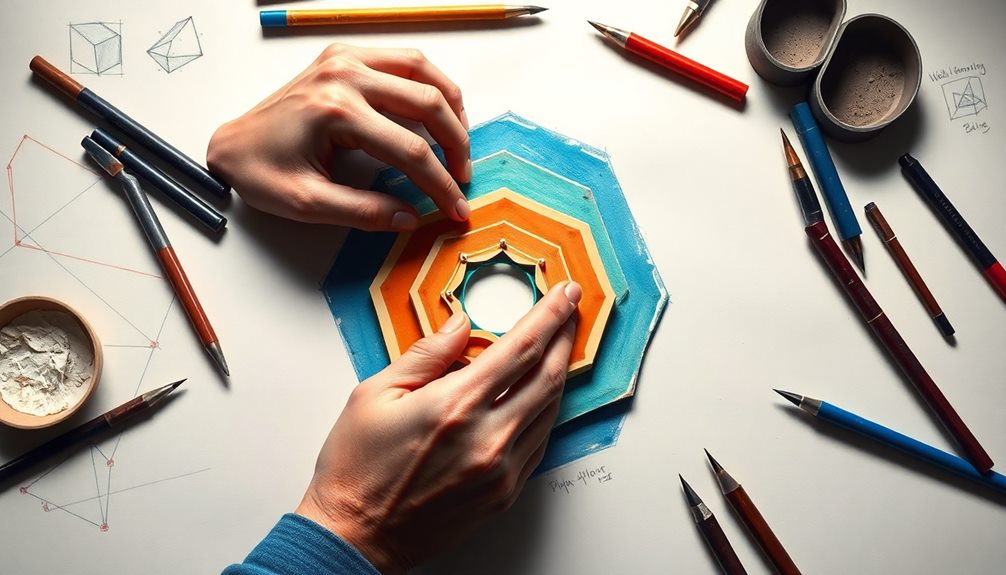
Mastering scale and proportion involves a blend of techniques that can greatly elevate your artistic endeavors. By applying these strategies, you'll create more compelling and harmonious compositions:
- Use grids and guidelines to maintain consistent proportions.
- Study classical artworks to understand historical approaches.
- Experiment with sizes to explore emotional responses.
- Apply the golden ratio to enhance visual harmony.
When you incorporate grids, you guarantee accurate scaling of images or objects, which helps you maintain relative size across your work.
Looking at Old Masters can inspire you and provide insights into effective scaling techniques. Don't shy away from experimentation—varying dimensions can considerably impact how viewers perceive your art.
The golden ratio, approximately 1.618, is a powerful tool that can create aesthetically pleasing proportions, guiding you toward balance in your compositions.
As you analyze successful designs from various disciplines, you'll refine your own techniques and develop a keen sense of how scale and proportion interact.
Common Mistakes
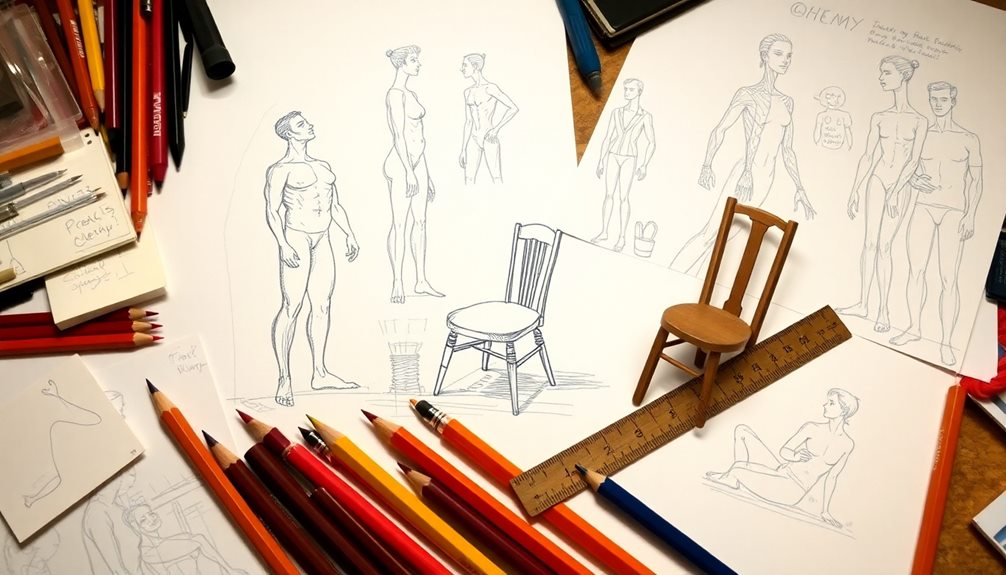
Common mistakes in scale and proportion can seriously undermine the effectiveness of your artwork. One of the most critical errors you might make is misjudging proportions. This can lead to unrealistic or awkward visuals that create discomfort or confusion for the viewer.
If elements don't relate properly, your composition may feel disjointed or chaotic, lacking the visual harmony necessary for an appealing piece.
Another common pitfall is overemphasizing one element, which disrupts the overall balance. This can make certain parts of your design appear overwhelming or out of place, throwing off the viewer's perception.
Relying solely on intuition without proper measurement can also lead to errors. You might overlook essential relationships between elements that need precise scaling and proportioning.
Understanding Scale

When you engage with the concept of scale, you'll find it plays a pivotal role in how your artwork communicates with viewers. Understanding scale is essential for creating a visual hierarchy and ensuring your message is clear. Here are some key points to contemplate:
- Scale influences the emotional response of viewers.
- Larger elements command more attention than smaller ones.
- Exaggerated scales can symbolize significant concepts in public art.
- Relative size comparisons enhance clarity and context.
By manipulating the size of objects in relation to one another, you can create focal points that guide the viewer's eye and enhance the overall composition.
For instance, a large sculpture can dominate a space, inviting people to engage more deeply with its meaning. In two-dimensional works, careful contemplation of scale can create the illusion of depth, making your piece more dynamic.
Ultimately, mastering scale helps you convey your artistic vision effectively. It's not just about making things look good; it's about ensuring that each element serves a purpose within the larger narrative of your work.
Exploring Proportion

Having explored the concept of scale, it's time to turn our attention to proportion, which plays an essential role in how elements interact within your artwork. Proportion assesses the size relationships among different components, helping you determine how they fit together in your composition.
You might find it helpful to reference the human body as a standard for judging proportion, as many artists do when aiming for realistic representations.
One renowned method for achieving pleasing proportions is the golden ratio, approximately 1.618. This ratio has been historically utilized in art and design to create balance and harmony. Correct proportions contribute to the overall aesthetic, while disproportionate elements can inject visual interest or tension, guiding the viewer's eye to specific areas.
You can perceive proportion in three ways: between parts of a single object, between an object and its environment, and among multiple objects viewed collectively.
Importance of Scale and Proportion

The importance of scale and proportion in your artwork can't be overstated; they guide the viewer's eye and establish key focal points that enhance visual clarity. When you get these elements right, you not only create balance but also evoke emotional responses that resonate with your audience.
Consider these key points about scale and proportion:
- Enhance Visual Clarity: Proper scale directs attention, making your message clearer.
- Create Harmony: Correct proportions foster balance in your composition, while distorted ones can add interest or tension.
- Impact Branding: Mastery of scale and proportion greatly influences how designs are perceived by consumers.
- Guide Interpretation: These elements allow you to manipulate how viewers engage with the narrative of your artwork.
Inaccurate scale can lead to confusion, negatively impacting user engagement and retention of information.
When you understand the crucial role that scale and proportion play, you'll be better equipped to create compelling visuals that not only attract attention but also communicate effectively.
Applications in Various Fields

Scale and proportion play essential roles across various fields, influencing functionality and aesthetics in ways that directly impact user experience.
In architecture, these principles guarantee that spaces accommodate human movement and interaction, creating structures that are both visually appealing and practical.
When you explore graphic design, you'll find that effective visual hierarchies rely heavily on scale and proportion to guide the viewer's eye and enhance readability in both print and digital media.
Fashion design also utilizes these principles, enhancing garment appeal by guaranteeing clothing fits well and flatters the human form. This is particularly vital in tailoring and pattern making.
Similarly, in interior design, applying scale and proportion helps achieve harmonious spaces. You'll notice how balancing furniture sizes and placements creates functional flow while maintaining visual interest in a room.
Frequently Asked Questions
How to Explain Scale and Proportion?
To explain scale and proportion, you can use simple comparisons. Describe how sizes relate to each other and how different parts fit within a whole. Visual examples can make your explanation clearer and more engaging.
What Is an Example of Proportion and Scale in Art?
You can see proportion and scale in Michelangelo's David. Its towering height exaggerates the figure's heroism, while Hokusai's Great Wave contrasts massive waves with tiny boats, emphasizing nature's dominance and creating dramatic tension in the artwork.
What Is an Example of Scale, Proportion, and Quantity?
You can see scale in the towering Eiffel Tower, proportion in the Parthenon's golden ratio, and quantity in model train sets, where miniature elements represent larger systems, creating a cohesive visual experience in design.
How Do You Describe Proportion and Scale in Interior Design?
Picture a symphony where every instrument blends perfectly; that's proportion and scale in interior design. You balance furniture sizes, ensuring each piece speaks harmoniously, creating a space that feels inviting and effortlessly functional for your lifestyle.
Conclusion
In summary, grasping scale and proportion is essential for creating visually appealing works in art and design. Did you know that nearly 70% of people find artwork more engaging when the proportions are balanced? By mastering these concepts, you not only enhance your creations but also connect better with your audience. So, keep experimenting with scale and proportion, and watch how your work transforms into something truly enchanting!

